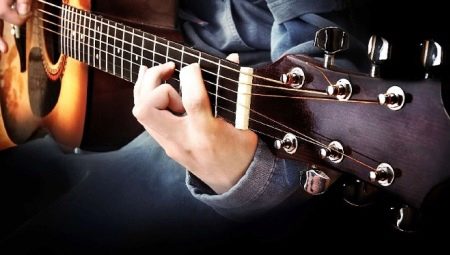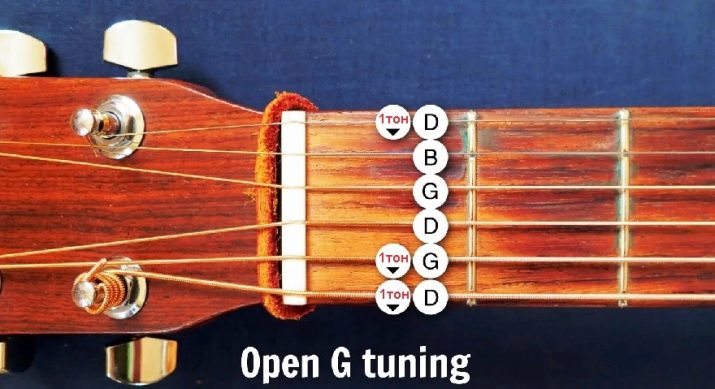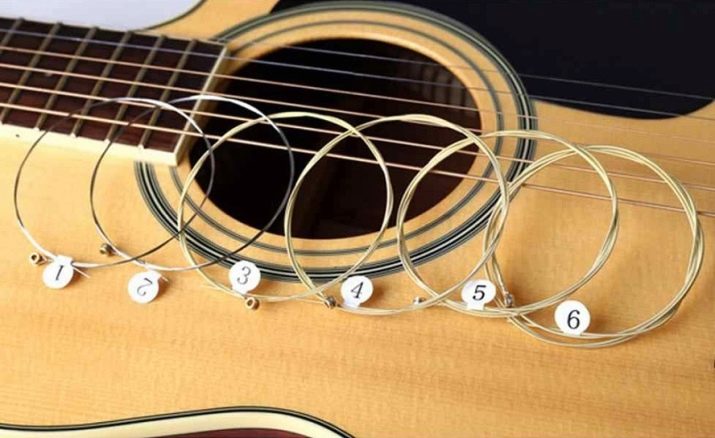Tuning Guitars Open G

The guitar is an amazing musical instrument that has conquered almost the entire world. It is also striking in the fact that it can be easily adjusted to any voice or other musical instrument by changing the scale in a matter of seconds. Six-string guitar has no less than twenty different tunings, which are popular among guitarists of different playing styles. One such tuning is the Open G tuning, which is especially popular with chanson performers. The features of this version of the guitar tuning and how it is played are described below.
Peculiarities
Now, no one can say for sure who came up with the idea of lowering the first, fifth and sixth strings on a standard six-string guitar 1 tone to get the open G major guitar tuning. But this is not so important, since the result is more important. And the result is a tuning in which all six open strings (that is, without clamping at the frets) of the instrument sound in a G major (G) chord.

Here is the actual sound of each string on a six-string tuned in G major:
- the first is the re of the first octave (denoted by D4);
- the second is the si of the small octave (B3);
- the third is a low octave salt (G3);
- the fourth is a small octave D (D3);
- the fifth is a large octave salt (G2);
- the sixth is a large octave D (D2).
It is customary to record a musical notation for a guitar one octave higher than its real sound, so as not to overload the text with additional rulers at the bottom of the staff, which complicate the musician's perception when reading notes from sight. In this case, the sounds of the open strings of a guitar tuned to the Open G tuning are displayed in notation as follows (in comparison with the standard classical tuning):

If you carefully compare the Open G tuning with the tuning of a standard classical guitar, you will notice that in the open G major tuning three strings - the second, third and fourth (highlighted in the picture above in red) - remained in the same tuning as the classical instrument ... At the same time, the remaining strings - the first, fifth and sixth - exactly correspond to the tunings of the first, sixth and seventh strings of the Russian 7-string guitar.
The result is a kind of hybrid, although it looks more like a seven-string (without one string).
What's the best string size?
For the open tuning in G major of conventional acoustic guitars with a standard scale, metal strings of caliber 10 to 11 with a sixth string of calibers 49-54 are quite suitable. It is generally believed that lowering the sound by a semitone-tone is quite acceptable for those strings that are originally installed on guitars of the standard - Spanish - tuning. In cases where the pitch drop range exceeds 1 tone, a thicker set must be installed to avoid beating overly weakened strings on the fretboard fretboard.

In our case, three strings are lowered by exactly one tone, so, it seems, there should not be much anxiety. However, there is an opinion that only when changing the pitch of all strings by the same interval at the same time, you can not worry about changing the set to a thicker gauge. Therefore, it would be more correct to change the kit to 10 or 11 gauge, if initially the acoustic or electric guitar will have strings of 8 or 9 caliber, before tuning to Open G. Above 11 gauge, you should not climb on acoustics, but on a rock guitar you can try if you want to get even more powerful sound from the bass.
But the recommendations above should not be considered rules. On which strings to play, the musician himself decides, focusing on his preferences and feelings. This question can be considered a purely personal matter of every guitarist.
Guitar tuning options
Any guitar (regular acoustics, electric guitar, rhythm, solo or bass) can be tuned to the desired tuning, including the open G tuning, in several ways:
- by ear using a tuning fork or other tuned musical instrument;
- by ear "for yourself", without using either a tuning fork or any musical instruments;
- using an electronic tuner (better chromatic, which is suitable for tuning guitar strings to any sounds).

With experience, of course, the skills of tuning the guitar by all the indicated methods will come, and for now only one of them will be available to beginners - with the help of an electronic tuner. The same guitarists who can play the usual six-string with a classical tuning, who are able to tune the strings to the E minor scale, will not be difficult to retrain a little to open tuning. They only need to lower the three required strings from the standard tuning, one tone lower than usual.
Let's take a closer look at each of the above methods of tuning a six-stringed instrument to G major open scale.
On a tuning fork (another musical instrument)
On a tuning fork that has the sound of an A of the first octave, you should tune the first string (the thinnest). To do this, you need to hold it down at the 7th fret, on which the identical sound is located. In this case, the open first string will sound the D note of the first octave, which is what we should have achieved.
After that, the tuning fork can be put aside, since it has obtained its own reference point - the tuned first string. It is she who will ensure the further correct tuning of the instrument.
The first open string can be brought to the desired tone without pressing, if there is another correctly tuned musical instrument. On this "other" instrument, the note D of the first octave is played, in unison of which the first open string must be pulled up or down.
And then it will be more convenient to continue the configuration in the order given below.
- The second string, pressed down at the third fret, should sound in unison with the first string open. Then, in a free (open) state, it will sound with a B note of a small octave.
- The third string is clamped at the 4th fret, tuning in this position to harmony with the open second. If this works out, then in the open state it will emit a note of G of a small octave, as required by the described scale G.
- String # 4 is clamped at the 5th fret and brought in unison to the sound of the third open. Thus, it will be possible to assume that when it is open it will sound with a note D of a small octave.
- The 5th string will need to be pressed down at the 7th fret, so that after tuning it to an open fourth, it sounds in a free position with a G note of a large octave.
- The sixth string will sound like a D sound of a large octave, if you press it on the V fret and tune in the fifth open.
To help with this algorithm, see the figure below, which shows the setting schematically:

By hearing "for yourself"
This option differs from the first only in that you need to tune the first string purely by ear, if there is such an experience... If there is no experience, then pull it to such a state that it does not dangle, but it is not too rigid, overtightened. And after that, the tuning should be performed according to the first method - each next string according to the previous one.
By tuner
The easiest and fastest option. It is necessary to put the tuner or the corresponding tuning program on the PC or smartphone into automatic mode and, extracting sounds from the strings, tighten the indicator readings to the required Latin letter symbols for sounds corresponding to the G tuning, that is, along the strings from the first: D4-B3-G3-D3 -G2-D2.
How to play in tuning?
Learning to play the guitar in open G tuning is not much different from any other tuning. It also starts with busting (arpeggios) on open strings, learning how to play sounds, joining the left hand, then learning chords, playing chromatic constructions and scales.
But there are also some peculiarities.
For example, in this tuning of the guitar it is more convenient to play the accompaniment to the songs, it is easier to pick up the barre (often with just one index finger).
All this contributes to rapid progress in the rhythm part, allows you to master various types of guitar fighting earlier. With this tuning, the bass sounds more powerful, sonorous, which, of course, motivates the musician for further success.
Here are some examples of guitar chords in G tuning that should be enough to get you started:

These chords need to be grouped into so-called boxes, consisting of interconnected harmonies, logically located and having a complete musical phrase.
For example, let's take these chord bundles:
- Am-F-G7-Am;
- A-D-E7-A;
- Em-Am-D7-Em.
By playing these boxes in a different rhythm and beat, you can work out the change of chords well, learn to play different types of rhythm, and study the guitar neck.
Besides, it is necessary to learn to understand tablature and musical notation of guitar parts (tabs and notes). For example, to understand a record like this:

This will triple your chances of becoming a good guitarist.








